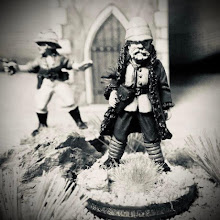German Imperial Marines protecting an ancient temple and artifacts from the troglodytes of the Witch King of Sokar.
Schutztruppe (literally "protection force") was the official name of the colonial troops in the African territories of the German colonial empire from the late 19th century. Similar to other colonial armies, the Schutztruppe consisted of
volunteer European commissioned and non-commissioned officers, medical
and veterinary officers. Most enlisted ranks were generally recruited
locally.
Herr Doktor Professor Kernel von Sanders with a contingent of Schutztruppe.
Military contingents were formed in German East Africa, where they became famous as Askari, in the Kamerun colony of German West Africa, and in German South-West Africa. Control of the German colonies of New Guinea, in Samoa, and in Togoland was performed by small local police detachments. Kiautschou in China under Imperial Navy administration was a notable exception. As part of the East Asian Station the navy garrisoned at Tsingtao the marines of
3rd Sea Battalion, the only all-German unit with permanent status in an overseas protectorate.
Name: Herr Doktor Professor Kernal von Sanders. A strong nationalist and humanitarian, von Sanders is vehemently opposed to the Society of Thule and uses his influence with the Imperial family, the court, his former military comrades (yes . . . he is that Oberst (Colonel) von Sanders) and the academic world.
Pluck: 2+
Leadership: +1
Speed: +0
Fighting Value: +2
Shooting Value: +2
Talents: Inspirational, Erudite Wit, Lighting Draw (pistol), Meticulous Planning
Basic Equipment: Cane Sword, pistol,
Armor: Magneto-Static Waistcoat
Cost: 63 points
A naval landing force of German marines under Hauptmann Richter support the Shutztruppe and Herr Doktor Professor von Sanders
In 1896 a central Schutztruppe command (
Kommando der Schutztruppen)
was established as part of the Colonial Department. Despite its name,
this agency exercised no military leadership but served as a mere
administrative authority. It was located at Berlin’s Mauerstrasse, in
proximity to the Colonial Office and Herr Doktor Professor von Sanders. From there he recruits young and promising officers to his cause.
Name: Hauptmann (Captain) Jurgen Richter.
Pluck: 3+
Leadership: +2
Speed: +1
Fighting Value: +4
Shooting Value: +2
Talents: Fearless, Fanatic, Impervious, Iron will, Duelist (sabre)
Basic Equipment: Pistol, sabre
Armor: SRC Breastplate
Cost: 77 points
Name: German Marine
Pluck: 5+
Leadership: 0
Speed: 0
Fighting Value: +2
Shooting Value: +2
Talents: Bayonet Drill
Basic Equipment: Military rifle, bayonet
Armor: Brigadine
Cost: 22 points
Hauptmann Richter leading a unit of Schutztruppe Askari into battle.
Name: Askari
Pluck: 5+
Leadership: 0
Speed: +1
Fighting Value: +2
Shooting Value: +1
Talents: Bayonet Drill
Basic Equipment: Military rifle, bayonet
Armor: Jack
Cost: 20
Tribal forces are used for scouting and skirmishing in the Schutztruppe.
Name: Veteran Warriors
Pluck: 4+
Speed: +2
Fighting Value: +2
Shooting Value: +1
Basic Equipment: Shield, spear and club
Armor: 8
Cost: 17 points
Name: Young Warriors
Pluck: 5+
Speed: +2
Fighting Value: +2
Shooting Value: 0
Basic Equipment: Shield, spear and club
Armor: 8
Cost: 14 points













































